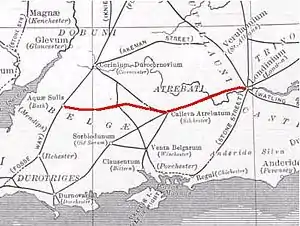
The Roman road from Silchester to Bath connected Calleva Atrebatum (Silchester) with Aquae Sulis (Bath) via Spinae (Speen), Cunetio (near Marlborough) and Verlucio (near Sandy Lane).[1] The road was a significant route for east–west travel and military logistics in south-east England during the 1st to 5th centuries.
Parts of its route were subsequently followed by earthworks that are presumed to form part of Wansdyke.[2] During the Middle Ages, the road was used by drovers, as well as by merchants and travellers.
Margary numbered the road as 53.[3] Portions of the Roman road are extant, while in other places all apparent vestiges are absent from view. In the early 19th century, Colt-Hoare surveyed and mapped its course from Overton Down (west of Marlborough) to Bath; the rest was only known in isolated sections until a study by Hugh Toller was published in 2013.[4]
See also
References
- ↑ Linford, N T; Linford, P K; Payne, A W (February 2018). "Verlucio and Environs Project, Bowood Estate, Calne Without, Wiltshire: Report on Geophysical Surveys". Historic England. Retrieved 5 August 2018.
- ↑ Wansdyke Project description of the Roman road from London to Bath
- ↑ Margary, Ivan D. (1955). Roman Roads in Britain, Vol. 1. London: Phoenix House. pp. 124–126 – via Internet Archive.
- ↑ Toller, Hugh (2013). "The Roman road between Wickham (Speen), Berkshire and Fyfield, Wiltshire (Margary 53)". Wiltshire Archaeological and Natural History Magazine. 106: 52–65 – via Biodiversity Heritage Library.
External links
- The road superimposed on a Google Map – saxonhistory.co.uk
51°21′32″N 1°01′54″W / 51.359°N 1.0318°W